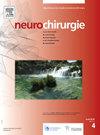Rethinking age barriers in Parkinson’s disease for deep brain stimulation
IF 1.4
4区 医学
Q4 CLINICAL NEUROLOGY
引用次数: 0
Abstract
Background
The age cutoff for subthalamic nucleus (STN) deep brain stimulation (DBS) in Parkinson's disease (PD) has been a contentious issue. Typically, it is offered to patients younger than 70 years. This study, however, aims to compare DBS efficacy outcomes between patients with age ≥70 years and those aged <70 years, potentially paving the way for a more inclusive approach to DBS in PD treatment.
Methods
This study is a retrospective, cross-sectional cohort study of PD patients who underwent STN-DBS between 2002 and 2019. The analysis included a comprehensive range of sociodemographic and clinical variables. The primary outcome was the reduction in Movement Disorder Society - Unified Parkinson's Disease Rating Scale part III (MDS-UDPRSIII). The secondary outcome was reduced levodopa equivalent daily dose (LEDD). The statistical analysis was performed in SPSS-25, with a stringent threshold of p < 0.05, to reject the null hypothesis, ensuring the robustness of our findings.
Results
From a cohort of 360 patients with PD who underwent STN-DBS, we included 15 patients 70 years or older with a mean age of 70.4 ± 0.9 years, a mean disease duration of 13.0 ± 2.8 years, and 61 patients younger than 70 years old with a mean age of 61.2 ± 6.6 years; median disease duration of 13.0 [IQR:10.0]. No significant statistical differences were found in the MDS-UPDRS-III score on both groups at the at baseline (p = 0.480), at one year (p = 0.341) and at three years of follow-up (p = 0.117). In both groups, postoperative reduction of LEDD was similar (35.7 [IQR: 33.91] vs 31.6 ± 18.3); (p = 0.960) in patients with age 70 years or older and those younger than 70 years respectively; nevertheless, patients with 70 years or older had higher LEDD at three years (p < 0.001).
Conclusion
Our study found no significant differences in the MDS-UPDRS-III in groups younger and older than 70 at baseline, at one year and at three years of follow-up. However, higher LEDD was necessary in the elderly group. This highlights the urgent need for more inclusive research to better understand the cost-effectiveness of DBS in this population. By conducting such research, we can ensure that all PD patients, regardless of age, have access to the most effective treatments.
重新思考帕金森病深部脑刺激的年龄障碍
背景:帕金森病(PD)的丘脑下核(STN)深部脑刺激(DBS)的年龄限制一直是一个有争议的问题。通常,它提供给70岁以下的患者。然而,这项研究的目的是比较年龄≥70岁和70岁患者的DBS疗效结果,可能为在PD治疗中采用更包容的DBS方法铺平道路。方法:本研究是一项回顾性、横断面队列研究,研究对象是2002年至2019年间接受STN-DBS治疗的PD患者。分析包括广泛的社会人口学和临床变量。主要结果是运动障碍协会-统一帕金森病评定量表第三部分(MDS-UDPRSIII)的降低。次要终点是左旋多巴当量日剂量(LEDD)降低。采用SPSS-25进行统计分析,采用严格的p <阈值;0.05,以拒绝原假设,确保我们的发现的稳健性。结果360例PD患者接受STN-DBS,其中15例70岁及以上患者,平均年龄70.4±0.9岁,平均病程13.0±2.8年;61例70岁以下患者,平均年龄61.2±6.6岁;中位病程13.0 [IQR:10.0]。两组患者在基线时(p = 0.480)、随访1年(p = 0.341)和随访3年(p = 0.117)的MDS-UPDRS-III评分均无统计学差异。两组术后LEDD减少量相似(35.7 [IQR: 33.91] vs 31.6±18.3);70岁及以上患者与70岁以下患者的差异(p = 0.960);然而,70岁及以上的患者在3年时的LEDD较高(p <;0.001)。我们的研究发现,在基线、1年和3年的随访中,年龄小于70岁和年龄大于70岁的两组的MDS-UPDRS-III无显著差异。然而,老年人需要更高的LEDD。这凸显了迫切需要进行更具包容性的研究,以更好地了解DBS在这一人群中的成本效益。通过开展这样的研究,我们可以确保所有PD患者,无论年龄大小,都能获得最有效的治疗。
本文章由计算机程序翻译,如有差异,请以英文原文为准。
求助全文
约1分钟内获得全文
求助全文
来源期刊

Neurochirurgie
医学-临床神经学
CiteScore
2.70
自引率
6.20%
发文量
100
审稿时长
29 days
期刊介绍:
Neurochirurgie publishes articles on treatment, teaching and research, neurosurgery training and the professional aspects of our discipline, and also the history and progress of neurosurgery. It focuses on pathologies of the head, spine and central and peripheral nervous systems and their vascularization. All aspects of the specialty are dealt with: trauma, tumor, degenerative disease, infection, vascular pathology, and radiosurgery, and pediatrics. Transversal studies are also welcome: neuroanatomy, neurophysiology, neurology, neuropediatrics, psychiatry, neuropsychology, physical medicine and neurologic rehabilitation, neuro-anesthesia, neurologic intensive care, neuroradiology, functional exploration, neuropathology, neuro-ophthalmology, otoneurology, maxillofacial surgery, neuro-endocrinology and spine surgery. Technical and methodological aspects are also taken onboard: diagnostic and therapeutic techniques, methods for assessing results, epidemiology, surgical, interventional and radiological techniques, simulations and pathophysiological hypotheses, and educational tools. The editorial board may refuse submissions that fail to meet the journal''s aims and scope; such studies will not be peer-reviewed, and the editor in chief will promptly inform the corresponding author, so as not to delay submission to a more suitable journal.
With a view to attracting an international audience of both readers and writers, Neurochirurgie especially welcomes articles in English, and gives priority to original studies. Other kinds of article - reviews, case reports, technical notes and meta-analyses - are equally published.
Every year, a special edition is dedicated to the topic selected by the French Society of Neurosurgery for its annual report.
 求助内容:
求助内容: 应助结果提醒方式:
应助结果提醒方式:


